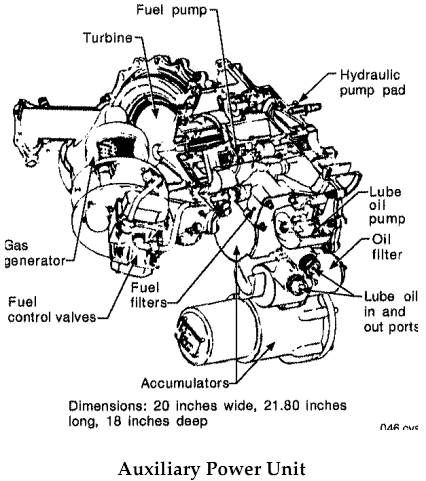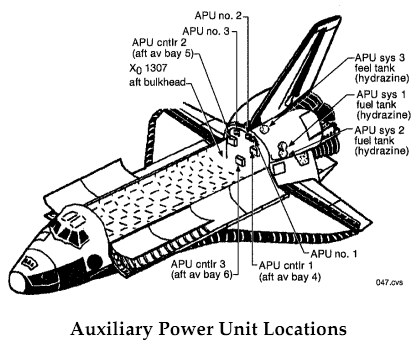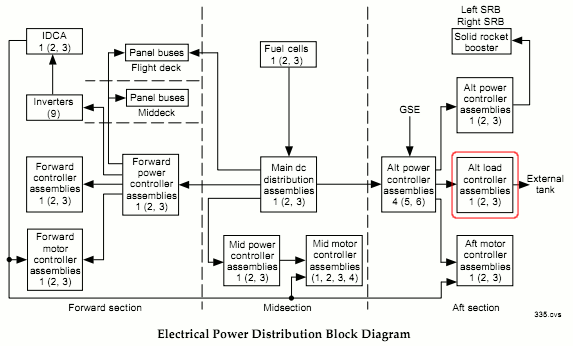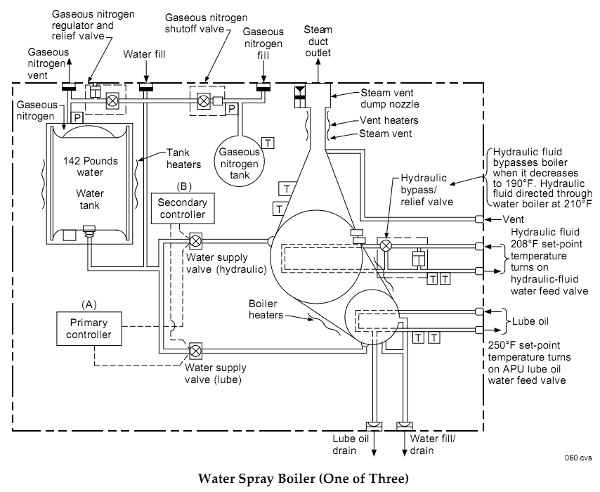The Space Shuttle has three independent hydraulic systems to operate engine valves, actuators, landing gear, and so forth during launch and landing. The hydraulic pumps are powered by three Auxiliary Power Units (or APUs), which are hydrazine-powered turbines. Each APU is 88 pounds and produces 135 horsepower (which is about the same horsepower as a Honda Accord).
Hydrazine is a highly-toxic rocket fuel; when exposed to a catalyst, it energetically decomposes into hot gases at 1700°F. It is convenient for applications such as the APU, since it doesn't need oxygen, and the decomposition can be easily started and stopped.

(Click on the image for tons of detailed information.)
Apparently the fuel heaters in APU 1 are not working. Since the hydrazine fuel will freeze at 34°F, each APU has redundant heaters to keep the system above 45°F. Since the heaters are redundant, the Space Shuttle would still be able to operate with the current problem, but would not be able to handle another failure. If the second fuel heater failed, then the fuel would freeze and the APU would not be able to work. Since there are three APUs, even this failure would not be a major problem. But still, you wouldn't want to take off with the heater not working, because losing hydraulic pressure would be a very bad thing.
According to articles, the fuel heater problem is due to a lack of power from the Aft Cabin Load Control Assembly, a switchbox that powers a heater circuit for Auxiliary Power Unit 1. There are three Aft Load Controller Assemblies, as well as many other Load Controller Assemblies. (Sources are inconsistent about whether it is called a Control vs Controller.)
A complex Electrical Power System provides power to all parts of the Shuttle. Three fuel cells (10 kW each) generate 28-volt direct current. The fuel cells feed three main DC power buses, as well as powering AC inverters to feed three AC buses with three-phase, 117-volt, 400-hertz AC power. From the fuel cell, power goes to a Distribution Assembly (DA), then to the aft Power Controller Assemblies, and then to the Aft Load Controller Assemblies.
The Load Control Assemblies contain solid-state switching devices for loads up to 20 amps, and relays for loads up to 135 amps. These switching devices are internally fused.
Reportedly there is a short or other electrical fault in the Aft Load Controller Assembly 2, which is causing the APU heater to fail to operate. The fuel is being drained from Endeavour so technicians can access the assembly and resolve the problem. If I'm interpreting everything correctly, it seems like they'll need to replace one of the internal fuses in the Load Control Assembly.
Complexity and the Space Shuttle
One amazing thing about the Space Shuttle is the layers and layers of complexity. The APU system is just one example of this. For instance, each APU has as lube oil system to keep it lubricated. This requires a lube oil pump, which requires a nitrogen pressurization system to start the pump in zero gravity. The oil also requires a 181-pound water spray boiler system, which sprays cooling water onto the oil pipes; the water boils into steam and is vented into space. The boiler requires controllers, panel switches, and status displays, as well as yet another nitrogen pressurization tank, and yet another system of heaters to keep the water from freezing.The water spray boiler doesn't have anything to do with the current launch delay, other than being part of the APU, but it provides an interesting example of the complexity of the systems involved. To summarize the complexity along just this one path, the engines require hydraulic pressure, which requires APUs to power the hydraulic pumps, which require a lubricating oil system, which requires a complex boiler system, which requires a own control and monitoring system. And this is just one small sub-path! I'm ignoring equally complex systems such as the APU injector cooling system (more water and pressurized nitrogen), or the APU fuel pump (which for instance, has a catch bottle in case its seals leak, a drain port if the catch bottle overflows, and associated monitoring system).
Conclusion
Given the level of complexity of the Space Shuttle, I'm not surprised by the launch delays, and wish NASA the best of luck in resolving the problem promptly. My opinion is while the Space Shuttle is a marvel of engineering, simpler rocket systems such as the SpaceX Falcon will turn out to be more practical in the long run.The images and much of the information above is from the 1988 Shuttle Reference Manual at shuttlepresskit.com. This manual goes into extreme detail and is very interesting (if you find this sort of thing interesting). I should probably make it clear that this posting is based on what I've read; I have no connection with the space program.
P.S. I've found extensive details on the LCA and launch issues are available at nasaspaceflight.com, e.g. Endeavour receives her new LCA – Blown driver examined.


